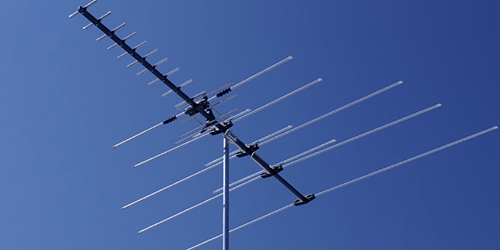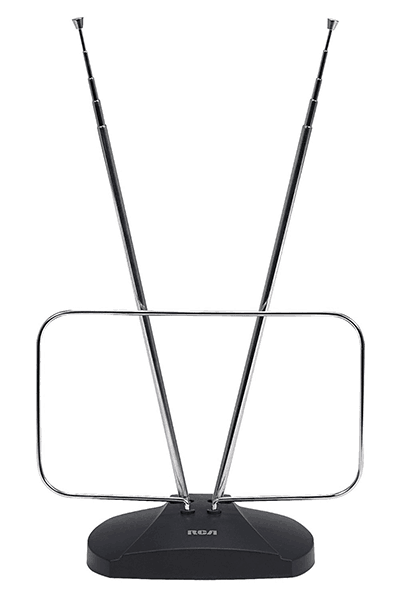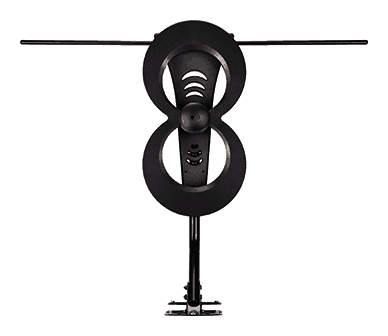If you're a regular reader, you know that we at Cordcutting.com love free over-the-air TV. Free OTA TV is one of the best ways to access live TV content as a cord cutter, and it's certainly one of the most affordable: once you've secured the right antenna, your access to OTA broadcasts is completely free. But there are a lot of different kinds of antennas out there, and it's sometimes hard to know which one of these different types of antennas you actually need – and that's to say nothing of the choices you'll have to make on brands and pricing. Today, we're going to try to demystify the different TV antenna types, so that you know what you're looking at when you see an antenna on the shelf at Walmart or online on Amazon. With the right terminology, you can quickly determine which type of antenna you need and why.
Types of Antennas: Building a Vocabulary
You might think that getting an antenna is simple: you figure out how far away your local TV stations are, and then you get an antenna that can handle that range. That's it, right?
Well, actually, sometimes it is. But, when it comes to antennas, one size does not fit all, and there are plenty of reasons why just walking out and buying an antenna with the “right” range might not be your best move. Maybe getting the range you need will require you to get an outdoor antenna, for instance, which could change your plans and make you reconsider how many channels you really want to pick up. Or maybe you'll find that your local stations are coming from all around you, and that even the most powerful directional antenna won't help you get them all. Terms like “outdoor TV antennas” and “directional TV antennas” can be confusing, so let's start our analysis of antenna types by looking at those terms and building our vocabulary.
Indoor vs. Outdoor Antennas (and “Indoor/Outdoor” Antennas)

Let's start with one of the most basic distinctions in the world of antennas: indoor vs. outdoor. As you no doubt guessed, indoor antennas are designed to be mounted indoors. They're generally going to end up mounted up somewhere high on your wall, and you'll just connect the coaxial cable to the back of your TV. Easy! Larger indoor antennas are usually flat rectangles or circles. Smaller ones may feature a little metal loop, old-school “rabbit ears,” or (more likely) both.
Outdoor antennas, of course, are meant to be mounted outdoors – usually high on the wall or on your roof. These come in a variety of forms, but most typically are either old-school wire “grill” antennas or bulkier versions of indoor antenna styles covered in weatherproof plastic. You'll still have to run a coaxial cable down from the antenna to your TV, and that means finding a way to get your coaxial cable through your walls. You may be able to use the coaxial cable system that (most likely) already exists in the walls of your home, though you shouldn't mix cable/internet signals with your antenna signal.
Indoor/outdoor antennas are antennas that can be used either indoors or outdoors. Their weatherproof features usually make them a bit bulkier than purely indoor antennas, but their versatility is a plus.
The obvious question, of course, is what determines whether you need an indoor or an outdoor antenna. One factor is range: there's a limit to how much range manufacturers can pack into indoor antennas, which tend to be significantly smaller than outdoor ones. Outdoor antennas can also be installed in higher places, like on the roof. But another key difference is that outdoor antennas are generally going to be directional, while indoor ones are virtually always omnidirectional – and this brings us to our next section.
Directional vs. Omnidirectional Antennas
“Omni” is a prefix that means “all,” so “omnidirectional” means “all directions.” In the context of antenna types, that means that omnidirectional antennas have a circular range: which way the broadcast is coming from doesn't matter much to them. Directional, then, means the opposite: the antenna needs to be pointed toward the source of the broadcast in order to pick up the channel clearly.
Directional antennas may have a narrow focus, but they make up for it by offering longer ranges. Omnidirectional antennas can grab you channels coming from all directions, but not from as far away.
So which one do you need? It depends, of course, on where your channels are coming from. If you live in the suburbs and are surrounded by local news stations, then an omnidirectional antenna is the way to go. If you live in a rural area and are trying to pick up stations based in the nearest urban or suburban area, you'll likely find that those stations are far from you but close to each other – making a directional antenna your best bet.
Amplified Antennas

Now let's talk about another type of antenna you might encounter: the amplified antenna. The thing about an amplified antenna is that, in a way, it's not really a kind of antenna at all. An amplifier is a device that can be added to an antenna, so you can take any antenna and turn it into an “amplified antenna” – types of antennas don't really matter in this case.
So what's an amplifier? Well, it's exactly what it sounds like: something that amplifies. In this case, what's being amplified is the signal your antenna is picking up. The amplifier takes that signal and makes it bigger, giving the signal wave higher highs and lower lows. Then it passes this new, easy-to-read signal on. Installed between your antenna and your TV, an amplifier can turn a weak signal into a clear, crisp one.
You can buy an amplifier on its own and add it to an unamplified antenna. Some antennas come with amplifiers in the box, and some actually have amplifiers built right into them. In all cases, all an amplifier is doing is making signals stronger, which can mean that channels that your antenna just barely picks up are unwatchably weak without an amplifier but clear with one.
UHF vs. VHF
We have saved perhaps the most confusing bit of vocabulary for last: UHF vs. VHF.
Both of these acronyms refer to types of broadcasts. Specifically, they refer to the ranges of frequencies in which you'll find OTA broadcasts. Antennas tune into specific frequencies to pick up specific channels, but those frequencies must fall within certain ranges.
The first of those ranges is between 30 MHz and 300 MHz. Those are very high frequencies, so the creative folks who came up with this stuff named that range of frequencies the “very high frequency” band – or VHF band. As soon as you over 300 MHz, you're into frequencies too high to be called merely very high; so the creative gang struck again and called the 300 MHz to 3 GHz range the “ultra high frequency” band, or UHF band.
It matters that these are different ranges, because when you put them together they form a range too wide for a single antenna. So UHF and VHF antennas are different types of antennas. But here's the good news: that doesn't mean that you have to buy two different kinds of antennas and install them both in order to get all of your channels.
Most antennas are capable of picking up both UHF and VHF frequencies, because most antennas are actually two different types of antennas in one: a UHF and VHF antenna, marketed as one big antenna. That's why, generally speaking, you're not going to have to worry much about the distinction between UHF and VHF. It's good to know, but your antenna will almost certainly pick up both, and should make that clear somewhere on the box or in the online description.
Putting It All Together: Different Types of Antennas, and Why You Might Need Them
Now we know the meaning of a few key identifiers of antennas. We know the meaning of indoor, outdoor, and indoor/outdoor; directional and omnidirectional; amplified and unamplified; and UHF and VHF. Without too much effort, then, we can also break down what it means to say something is an “amplified omnidirectional indoor antenna” or a “directional outdoor antenna.”
Now let's take a look at some specific types of antennas, using our new vocabulary to describe them. Since certain traits of these antennas go together (for instance, outdoor antennas are usually directional antennas), we can present them in a pretty sensible order, going from the smallest and weakest to the biggest and baddest. Along the way, we'll talk about what might make you choose each of these types of antennas for your space.
Small Omnidirectional Indoor Antenna

Super-affordable indoor antennas tend to feature the “rabbit ears” or loop design. They'll only give you short-range coverage, but they're more than enough for urban dwellers. Because of significant design differences between the rabbit-ear set and the flat-antenna set, we're considering small omnidirectional antennas to be a different kind of antenna than medium and large ones for the purposes of this list.
You should get one if: You live in a city or a dense suburb and your local broadcast towers are within a 10 or 15 miles of you.
Omnidirectional Indoor Antennas

These sorts of omnidirectional indoor antennas are extremely popular among cord cutters. Urban and suburban residents will find they can get plenty of range out of antennas like this without having to get anything bulky or install something outside. These types of antennas come in various sizes, and are sometimes roughly grouped as “medium” and “large” indoor antennas (the “small” ones are the ones we covered in the last section).
You should get one if: You live in a city or suburb and your local broadcast towers are within the range of the antenna you're considering (these antennas offer ranges between 20 and 50 miles, give or take).
Amplified Omnidirectional Indoor Antenna

If a regular indoor antenna isn't enough, you may want to consider amplification. Amplifying an indoor antenna can help you get range that approaches that of outdoor antennas. That's a nice thing if you need long-range coverage but don't have most of your broadcasts coming at you from the same direction. It's also nice if you don't want to climb around on the roof.
You should get one if: Your broadcasts are a long way off, but coming from all over; or if you want coverage that approaches outdoor antenna-range without having to actually get an outdoor antenna.
Indoor/Outdoor Antennas

Indoor/outdoor antennas can be omnidirectional, which is something that purely outdoor antennas rarely are (and purely indoor antennas almost always are). They tend to be amplified, and they tend to be powerful. They're generally much smaller than the big metal rooftop antennas. They also tend to be a bit less attractive than purely indoor antennas, but hey, what can you do.
You should get one if: You need a more powerful antenna (broadcast towers 40-50 miles or more away) but don't want a full-blown rooftop oudoor antenna. Their flexibility and strong range also makes them a good option for RV owners.
Directional Outdoor Antennas

Nothing beats the range and power of a directional outdoor antenna. They're a pain to set up and they can be rougher on the eyes than their indoor counterparts, but they can offer stunning ranges of up to []. The catch, of course, is that directional outdoor antennas need to be pointed at the source of broadcasts. That usually works out fine, because these antennas are best suited for rural areas, and most rural residents will find that most of their nearby channels are coming from one direction, which is also likely the direction of the nearest population center.
You should get one if: You live in a rural area and need serious range in order to pick up channels from the nearest cluster of broadcast stations.
Choosing the Right Antenna for You
Knowledge is power, and it's time to put that power to use and get you the right type of antenna. Knowing which of the types of antennas we just learned about is right for you means finding out where you local stations are, among other things. But we're overstepping the bounds of this post, so we'll have to direct you to another: click here to learn how to choose the right antenna.
https://cordcutting.com/how-to-choose-the-best-tv-antenna-for-your-needs/
